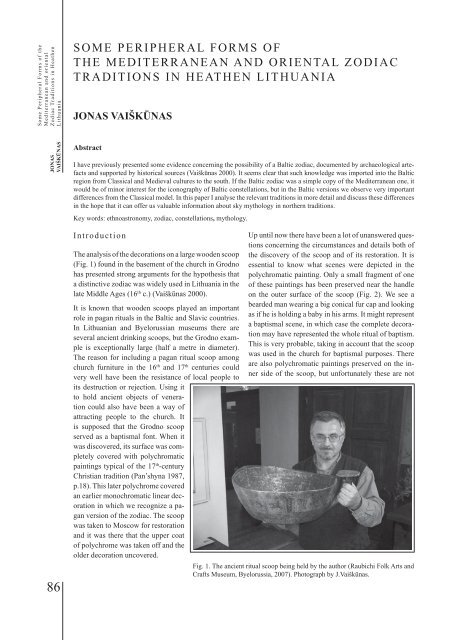BALTICA10
BALTICA10
BALTICA10
You also want an ePaper? Increase the reach of your titles
YUMPU automatically turns print PDFs into web optimized ePapers that Google loves.
Some Peripheral Forms of the<br />
Mediterranean and oriental<br />
Zodiac Traditions in Heathen<br />
Lithuania<br />
SOME PERIPHERAL FORMS OF<br />
THE MEDITERRANEAN AND ORIENTAL ZODIAC<br />
TRADITIONS IN HEATHEN LITHUANIA<br />
JONAS VAIŠKŪNAS<br />
JONAS<br />
VAIŠKŪNAS<br />
Abstract<br />
I have previously presented some evidence concerning the possibility of a Baltic zodiac, documented by archaeological artefacts<br />
and supported by historical sources (Vaiškūnas 2000). It seems clear that such knowledge was imported into the Baltic<br />
region from Classical and Medieval cultures to the south. If the Baltic zodiac was a simple copy of the Mediterranean one, it<br />
would be of minor interest for the iconography of Baltic constellations, but in the Baltic versions we observe very important<br />
differences from the Classical model. In this paper I analyse the relevant traditions in more detail and discuss these differences<br />
in the hope that it can offer us valuable information about sky mythology in northern traditions.<br />
Key words: ethnoastronomy, zodiac, constellations, mythology.<br />
86<br />
Introduction<br />
The analysis of the decorations on a large wooden scoop<br />
(Fig. 1) found in the basement of the church in Grodno<br />
has presented strong arguments for the hypothesis that<br />
a distinctive zodiac was widely used in Lithuania in the<br />
late Middle Ages (16 th c.) (Vaiškūnas 2000).<br />
It is known that wooden scoops played an important<br />
role in pagan rituals in the Baltic and Slavic countries.<br />
In Lithuanian and Byelorussian museums there are<br />
several ancient drinking scoops, but the Grodno example<br />
is exceptionally large (half a metre in diameter).<br />
The reason for including a pagan ritual scoop among<br />
church furniture in the 16 th and 17 th centuries could<br />
very well have been the resistance of local people to<br />
its destruction or rejection. Using it<br />
to hold ancient objects of veneration<br />
could also have been a way of<br />
attracting people to the church. It<br />
is supposed that the Grodno scoop<br />
served as a baptismal font. When it<br />
was discovered, its surface was completely<br />
covered with polychromatic<br />
paintings typical of the 17 th -century<br />
Christian tradition (Pan’shyna 1987,<br />
p.18). This later polychrome covered<br />
an earlier monochromatic linear decoration<br />
in which we recognize a pagan<br />
version of the zodiac. The scoop<br />
was taken to Moscow for restoration<br />
and it was there that the upper coat<br />
of polychrome was taken off and the<br />
older decoration uncovered.<br />
Up until now there have been a lot of unanswered questions<br />
concerning the circumstances and details both of<br />
the discovery of the scoop and of its restoration. It is<br />
essential to know what scenes were depicted in the<br />
polychromatic painting. Only a small fragment of one<br />
of these paintings has been preserved near the handle<br />
on the outer surface of the scoop (Fig. 2). We see a<br />
bearded man wearing a big conical fur cap and looking<br />
as if he is holding a baby in his arms. It might represent<br />
a baptismal scene, in which case the complete decoration<br />
may have represented the whole ritual of baptism.<br />
This is very probable, taking in account that the scoop<br />
was used in the church for baptismal purposes. There<br />
are also polychromatic paintings preserved on the inner<br />
side of the scoop, but unfortunately these are not<br />
Fig. 1. The ancient ritual scoop being held by the author (Raubichi Folk Arts and<br />
Crafts Museum, Byelorussia, 2007). Photograph by J.Vaiškūnas.
















